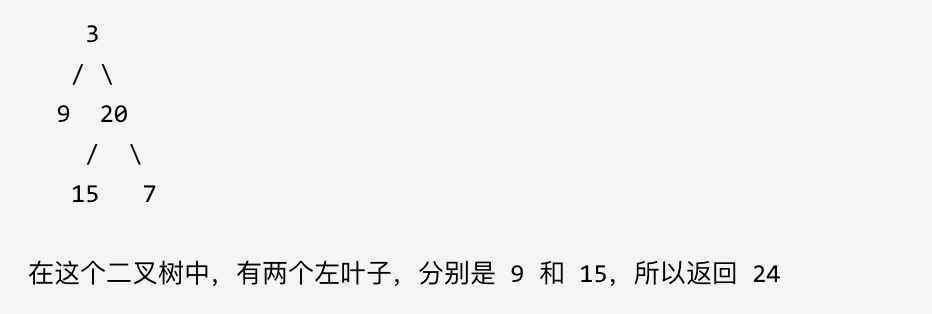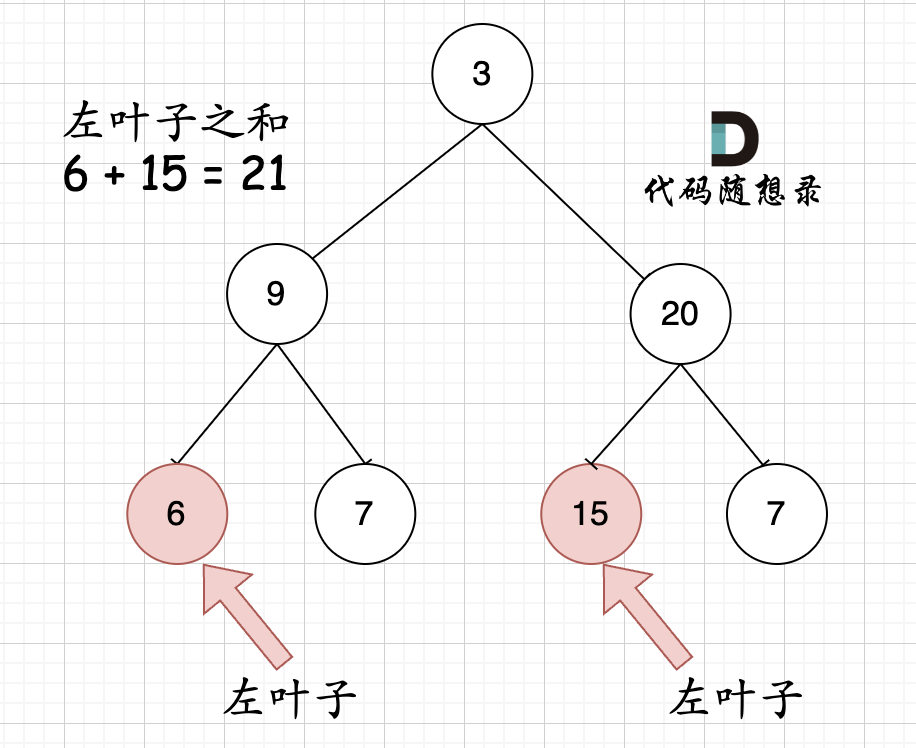- 做项目(多个C++、Java、Go、测开、前端项目) (opens new window)
- 刷算法(两个月高强度学算法) (opens new window)
- 背八股(40天挑战高频面试题) (opens new window)
# 404.左叶子之和
计算给定二叉树的所有左叶子之和。
示例:

# 算法公开课
《代码随想录》算法视频公开课 (opens new window)::二叉树的题目中,总有一些规则让你找不到北 | LeetCode:404.左叶子之和 (opens new window),相信结合视频在看本篇题解,更有助于大家对本题的理解。
# 思路
首先要注意是判断左叶子,不是二叉树左侧节点,所以不要上来想着层序遍历。
因为题目中其实没有说清楚左叶子究竟是什么节点,那么我来给出左叶子的明确定义:节点A的左孩子不为空,且左孩子的左右孩子都为空(说明是叶子节点),那么A节点的左孩子为左叶子节点
大家思考一下如下图中二叉树,左叶子之和究竟是多少?
 其实是0,因为这棵树根本没有左叶子!
其实是0,因为这棵树根本没有左叶子!
但看这个图的左叶子之和是多少?

相信通过这两个图,大家对最左叶子的定义有明确理解了。
那么判断当前节点是不是左叶子是无法判断的,必须要通过节点的父节点来判断其左孩子是不是左叶子。
如果该节点的左节点不为空,该节点的左节点的左节点为空,该节点的左节点的右节点为空,则找到了一个左叶子,判断代码如下:
if (node->left != NULL && node->left->left == NULL && node->left->right == NULL) {
左叶子节点处理逻辑
}
2
3
# 递归法
递归的遍历顺序为后序遍历(左右中),是因为要通过递归函数的返回值来累加求取左叶子数值之和。
递归三部曲:
- 确定递归函数的参数和返回值
判断一个树的左叶子节点之和,那么一定要传入树的根节点,递归函数的返回值为数值之和,所以为int
使用题目中给出的函数就可以了。
- 确定终止条件
如果遍历到空节点,那么左叶子值一定是0
if (root == NULL) return 0;
注意,只有当前遍历的节点是父节点,才能判断其子节点是不是左叶子。 所以如果当前遍历的节点是叶子节点,那其左叶子也必定是0,那么终止条件为:
if (root == NULL) return 0;
if (root->left == NULL && root->right== NULL) return 0; //其实这个也可以不写,如果不写不影响结果,但就会让递归多进行了一层。
2
- 确定单层递归的逻辑
当遇到左叶子节点的时候,记录数值,然后通过递归求取左子树左叶子之和,和 右子树左叶子之和,相加便是整个树的左叶子之和。
代码如下:
int leftValue = sumOfLeftLeaves(root->left); // 左
if (root->left && !root->left->left && !root->left->right) {
leftValue = root->left->val;
}
int rightValue = sumOfLeftLeaves(root->right); // 右
int sum = leftValue + rightValue; // 中
return sum;
2
3
4
5
6
7
8
9
整体递归代码如下:
class Solution {
public:
int sumOfLeftLeaves(TreeNode* root) {
if (root == NULL) return 0;
if (root->left == NULL && root->right== NULL) return 0;
int leftValue = sumOfLeftLeaves(root->left); // 左
if (root->left && !root->left->left && !root->left->right) { // 左子树就是一个左叶子的情况
leftValue = root->left->val;
}
int rightValue = sumOfLeftLeaves(root->right); // 右
int sum = leftValue + rightValue; // 中
return sum;
}
};
2
3
4
5
6
7
8
9
10
11
12
13
14
15
16
17
以上代码精简之后如下:
class Solution {
public:
int sumOfLeftLeaves(TreeNode* root) {
if (root == NULL) return 0;
int leftValue = 0;
if (root->left != NULL && root->left->left == NULL && root->left->right == NULL) {
leftValue = root->left->val;
}
return leftValue + sumOfLeftLeaves(root->left) + sumOfLeftLeaves(root->right);
}
};
2
3
4
5
6
7
8
9
10
11
精简之后的代码其实看不出来用的是什么遍历方式了,对于算法初学者以上根据第一个版本来学习。
# 迭代法
本题迭代法使用前中后序都是可以的,只要把左叶子节点统计出来,就可以了,那么参考文章 二叉树:听说递归能做的,栈也能做! (opens new window)和二叉树:迭代法统一写法 (opens new window)中的写法,可以写出一个前序遍历的迭代法。
判断条件都是一样的,代码如下:
class Solution {
public:
int sumOfLeftLeaves(TreeNode* root) {
stack<TreeNode*> st;
if (root == NULL) return 0;
st.push(root);
int result = 0;
while (!st.empty()) {
TreeNode* node = st.top();
st.pop();
if (node->left != NULL && node->left->left == NULL && node->left->right == NULL) {
result += node->left->val;
}
if (node->right) st.push(node->right);
if (node->left) st.push(node->left);
}
return result;
}
};
2
3
4
5
6
7
8
9
10
11
12
13
14
15
16
17
18
19
20
# 总结
这道题目要求左叶子之和,其实是比较绕的,因为不能判断本节点是不是左叶子节点。
此时就要通过节点的父节点来判断其左孩子是不是左叶子了。
平时我们解二叉树的题目时,已经习惯了通过节点的左右孩子判断本节点的属性,而本题我们要通过节点的父节点判断本节点的属性。
希望通过这道题目,可以扩展大家对二叉树的解题思路。
# 其他语言版本
# Java:
递归
class Solution {
public int sumOfLeftLeaves(TreeNode root) {
if (root == null) return 0;
int leftValue = sumOfLeftLeaves(root.left); // 左
int rightValue = sumOfLeftLeaves(root.right); // 右
int midValue = 0;
if (root.left != null && root.left.left == null && root.left.right == null) {
midValue = root.left.val;
}
int sum = midValue + leftValue + rightValue; // 中
return sum;
}
}
2
3
4
5
6
7
8
9
10
11
12
13
14
迭代
class Solution {
public int sumOfLeftLeaves(TreeNode root) {
if (root == null) return 0;
Stack<TreeNode> stack = new Stack<> ();
stack.add(root);
int result = 0;
while (!stack.isEmpty()) {
TreeNode node = stack.pop();
if (node.left != null && node.left.left == null && node.left.right == null) {
result += node.left.val;
}
if (node.right != null) stack.add(node.right);
if (node.left != null) stack.add(node.left);
}
return result;
}
}
2
3
4
5
6
7
8
9
10
11
12
13
14
15
16
17
// 层序遍历迭代法
class Solution {
public int sumOfLeftLeaves(TreeNode root) {
int sum = 0;
if (root == null) return 0;
Queue<TreeNode> queue = new LinkedList<>();
queue.offer(root);
while (!queue.isEmpty()) {
int size = queue.size();
while (size -- > 0) {
TreeNode node = queue.poll();
if (node.left != null) { // 左节点不为空
queue.offer(node.left);
if (node.left.left == null && node.left.right == null){ // 左叶子节点
sum += node.left.val;
}
}
if (node.right != null) queue.offer(node.right);
}
}
return sum;
}
}
2
3
4
5
6
7
8
9
10
11
12
13
14
15
16
17
18
19
20
21
22
23
# Python:
递归
# Definition for a binary tree node.
# class TreeNode:
# def __init__(self, val=0, left=None, right=None):
# self.val = val
# self.left = left
# self.right = right
class Solution:
def sumOfLeftLeaves(self, root):
if root is None:
return 0
if root.left is None and root.right is None:
return 0
leftValue = self.sumOfLeftLeaves(root.left) # 左
if root.left and not root.left.left and not root.left.right: # 左子树是左叶子的情况
leftValue = root.left.val
rightValue = self.sumOfLeftLeaves(root.right) # 右
sum_val = leftValue + rightValue # 中
return sum_val
2
3
4
5
6
7
8
9
10
11
12
13
14
15
16
17
18
19
20
21
递归精简版
# Definition for a binary tree node.
# class TreeNode:
# def __init__(self, val=0, left=None, right=None):
# self.val = val
# self.left = left
# self.right = right
class Solution:
def sumOfLeftLeaves(self, root):
if root is None:
return 0
leftValue = 0
if root.left is not None and root.left.left is None and root.left.right is None:
leftValue = root.left.val
return leftValue + self.sumOfLeftLeaves(root.left) + self.sumOfLeftLeaves(root.right)
2
3
4
5
6
7
8
9
10
11
12
13
14
迭代法
# Definition for a binary tree node.
# class TreeNode:
# def __init__(self, val=0, left=None, right=None):
# self.val = val
# self.left = left
# self.right = right
class Solution:
def sumOfLeftLeaves(self, root):
if root is None:
return 0
st = [root]
result = 0
while st:
node = st.pop()
if node.left and node.left.left is None and node.left.right is None:
result += node.left.val
if node.right:
st.append(node.right)
if node.left:
st.append(node.left)
return result
2
3
4
5
6
7
8
9
10
11
12
13
14
15
16
17
18
19
20
21
22
# Go:
递归法
func sumOfLeftLeaves(root *TreeNode) int {
if root == nil {
return 0
}
leftValue := sumOfLeftLeaves(root.Left) // 左
if root.Left != nil && root.Left.Left == nil && root.Left.Right == nil {
leftValue = root.Left.Val // 中
}
rightValue := sumOfLeftLeaves(root.Right) // 右
return leftValue + rightValue
}
2
3
4
5
6
7
8
9
10
11
12
13
14
递归精简版
func sumOfLeftLeaves(root *TreeNode) int {
if root == nil {
return 0
}
leftValue := 0
if root.Left != nil && root.Left.Left == nil && root.Left.Right == nil {
leftValue = root.Left.Val
}
return leftValue + sumOfLeftLeaves(root.Left) + sumOfLeftLeaves(root.Right)
}
2
3
4
5
6
7
8
9
10
迭代法(前序遍历)
func sumOfLeftLeaves(root *TreeNode) int {
st := make([]*TreeNode, 0)
if root == nil {
return 0
}
st = append(st, root)
result := 0
for len(st) != 0 {
node := st[len(st)-1]
st = st[:len(st)-1]
if node.Left != nil && node.Left.Left == nil && node.Left.Right == nil {
result += node.Left.Val
}
if node.Right != nil {
st = append(st, node.Right)
}
if node.Left != nil {
st = append(st, node.Left)
}
}
return result
}
2
3
4
5
6
7
8
9
10
11
12
13
14
15
16
17
18
19
20
21
22
23
24
25
# JavaScript:
递归法
var sumOfLeftLeaves = function(root) {
//采用后序遍历 递归遍历
// 1. 确定递归函数参数
const nodesSum = function(node) {
// 2. 确定终止条件
if(node === null) {
return 0;
}
let leftValue = nodesSum(node.left);
let rightValue = nodesSum(node.right);
// 3. 单层递归逻辑
let midValue = 0;
if(node.left && node.left.left === null && node.left.right === null) {
midValue = node.left.val;
}
let sum = midValue + leftValue + rightValue;
return sum;
}
return nodesSum(root);
};
2
3
4
5
6
7
8
9
10
11
12
13
14
15
16
17
18
19
20
迭代法
var sumOfLeftLeaves = function(root) {
//采用层序遍历
if(root === null) {
return null;
}
let queue = [];
let sum = 0;
queue.push(root);
while(queue.length) {
let node = queue.shift();
if(node.left !== null && node.left.left === null && node.left.right === null) {
sum+=node.left.val;
}
node.left && queue.push(node.left);
node.right && queue.push(node.right);
}
return sum;
};
2
3
4
5
6
7
8
9
10
11
12
13
14
15
16
17
18
# TypeScript:
递归法
function sumOfLeftLeaves(root: TreeNode | null): number {
if (root === null) return 0;
let midVal: number = 0;
if (
root.left !== null &&
root.left.left === null &&
root.left.right === null
) {
midVal = root.left.val;
}
let leftVal: number = sumOfLeftLeaves(root.left);
let rightVal: number = sumOfLeftLeaves(root.right);
return midVal + leftVal + rightVal;
};
2
3
4
5
6
7
8
9
10
11
12
13
14
迭代法
function sumOfLeftLeaves(root: TreeNode | null): number {
let helperStack: TreeNode[] = [];
let tempNode: TreeNode;
let sum: number = 0;
if (root !== null) helperStack.push(root);
while (helperStack.length > 0) {
tempNode = helperStack.pop()!;
if (
tempNode.left !== null &&
tempNode.left.left === null &&
tempNode.left.right === null
) {
sum += tempNode.left.val;
}
if (tempNode.right !== null) helperStack.push(tempNode.right);
if (tempNode.left !== null) helperStack.push(tempNode.left);
}
return sum;
};
2
3
4
5
6
7
8
9
10
11
12
13
14
15
16
17
18
19
# Swift:
递归法
func sumOfLeftLeaves(_ root: TreeNode?) -> Int {
guard let root = root else {
return 0
}
let leftValue = sumOfLeftLeaves(root.left)
let rightValue = sumOfLeftLeaves(root.right)
var midValue: Int = 0
if root.left != nil && root.left?.left == nil && root.left?.right == nil {
midValue = root.left!.val
}
let sum = midValue + leftValue + rightValue
return sum
}
2
3
4
5
6
7
8
9
10
11
12
13
14
15
16
迭代法
func sumOfLeftLeaves(_ root: TreeNode?) -> Int {
guard let root = root else {
return 0
}
var stack = Array<TreeNode>()
stack.append(root)
var sum = 0
while !stack.isEmpty {
let lastNode = stack.removeLast()
if lastNode.left != nil && lastNode.left?.left == nil && lastNode.left?.right == nil {
sum += lastNode.left!.val
}
if let right = lastNode.right {
stack.append(right)
}
if let left = lastNode.left {
stack.append(left)
}
}
return sum
}
2
3
4
5
6
7
8
9
10
11
12
13
14
15
16
17
18
19
20
21
22
23
24
# C:
递归法:
int sumOfLeftLeaves(struct TreeNode* root){
// 递归结束条件:若当前结点为空,返回0
if(!root)
return 0;
// 递归取左子树的左结点和和右子树的左结点和
int leftValue = sumOfLeftLeaves(root->left);
int rightValue = sumOfLeftLeaves(root->right);
// 若当前结点的左结点存在,且其为叶子结点。取它的值
int midValue = 0;
if(root->left && (!root->left->left && !root->left->right))
midValue = root->left->val;
return leftValue + rightValue + midValue;
}
2
3
4
5
6
7
8
9
10
11
12
13
14
15
16
迭代法:
int sumOfLeftLeaves(struct TreeNode* root){
struct TreeNode* stack[1000];
int stackTop = 0;
// 若传入root结点不为空,将其入栈
if(root)
stack[stackTop++] = root;
int sum = 0;
//若栈不为空,进行循环
while(stackTop) {
// 出栈栈顶元素
struct TreeNode *topNode = stack[--stackTop];
// 若栈顶元素的左孩子为左叶子结点,将其值加入sum中
if(topNode->left && (!topNode->left->left && !topNode->left->right))
sum += topNode->left->val;
// 若当前栈顶结点有左右孩子。将他们加入栈中进行遍历
if(topNode->right)
stack[stackTop++] = topNode->right;
if(topNode->left)
stack[stackTop++] = topNode->left;
}
return sum;
}
2
3
4
5
6
7
8
9
10
11
12
13
14
15
16
17
18
19
20
21
22
23
24
25
# Scala:
递归:
object Solution {
def sumOfLeftLeaves(root: TreeNode): Int = {
if(root == null) return 0
var midValue = 0
if(root.left != null && root.left.left == null && root.left.right == null){
midValue = root.left.value
}
// return关键字可以省略
midValue + sumOfLeftLeaves(root.left) + sumOfLeftLeaves(root.right)
}
}
2
3
4
5
6
7
8
9
10
11
迭代:
object Solution {
import scala.collection.mutable
def sumOfLeftLeaves(root: TreeNode): Int = {
val stack = mutable.Stack[TreeNode]()
if (root == null) return 0
stack.push(root)
var sum = 0
while (!stack.isEmpty) {
val curNode = stack.pop()
if (curNode.left != null && curNode.left.left == null && curNode.left.right == null) {
sum += curNode.left.value // 如果满足条件就累加
}
if (curNode.right != null) stack.push(curNode.right)
if (curNode.left != null) stack.push(curNode.left)
}
sum
}
}
2
3
4
5
6
7
8
9
10
11
12
13
14
15
16
17
18
# Rust:
递归
use std::cell::RefCell;
use std::rc::Rc;
impl Solution {
pub fn sum_of_left_leaves(root: Option<Rc<RefCell<TreeNode>>>) -> i32 {
let mut res = 0;
if let Some(node) = root {
if let Some(left) = &node.borrow().left {
if left.borrow().right.is_none() && left.borrow().right.is_none() {
res += left.borrow().val;
}
}
res + Self::sum_of_left_leaves(node.borrow().left.clone())
+ Self::sum_of_left_leaves(node.borrow().right.clone())
} else {
0
}
}
}
2
3
4
5
6
7
8
9
10
11
12
13
14
15
16
17
18
迭代:
use std::cell::RefCell;
use std::rc::Rc;
impl Solution {
pub fn sum_of_left_leaves(root: Option<Rc<RefCell<TreeNode>>>) -> i32 {
let mut res = 0;
let mut stack = vec![root];
while !stack.is_empty() {
if let Some(node) = stack.pop().unwrap() {
if let Some(left) = &node.borrow().left {
if left.borrow().left.is_none() && left.borrow().right.is_none() {
res += left.borrow().val;
}
stack.push(Some(left.to_owned()));
}
if let Some(right) = &node.borrow().right {
stack.push(Some(right.to_owned()));
}
}
}
res
}
}
2
3
4
5
6
7
8
9
10
11
12
13
14
15
16
17
18
19
20
21
22
# C#
// 递归
public int SumOfLeftLeaves(TreeNode root)
{
if (root == null) return 0;
int leftValue = SumOfLeftLeaves(root.left);
if (root.left != null && root.left.left == null && root.left.right == null)
{
leftValue += root.left.val;
}
int rightValue = SumOfLeftLeaves(root.right);
return leftValue + rightValue;
}
2
3
4
5
6
7
8
9
10
11
12
13
14
